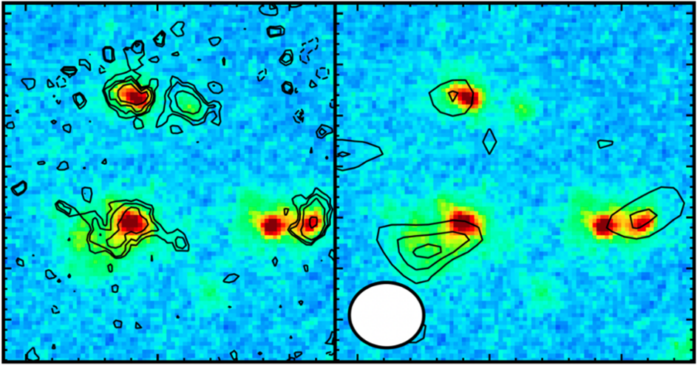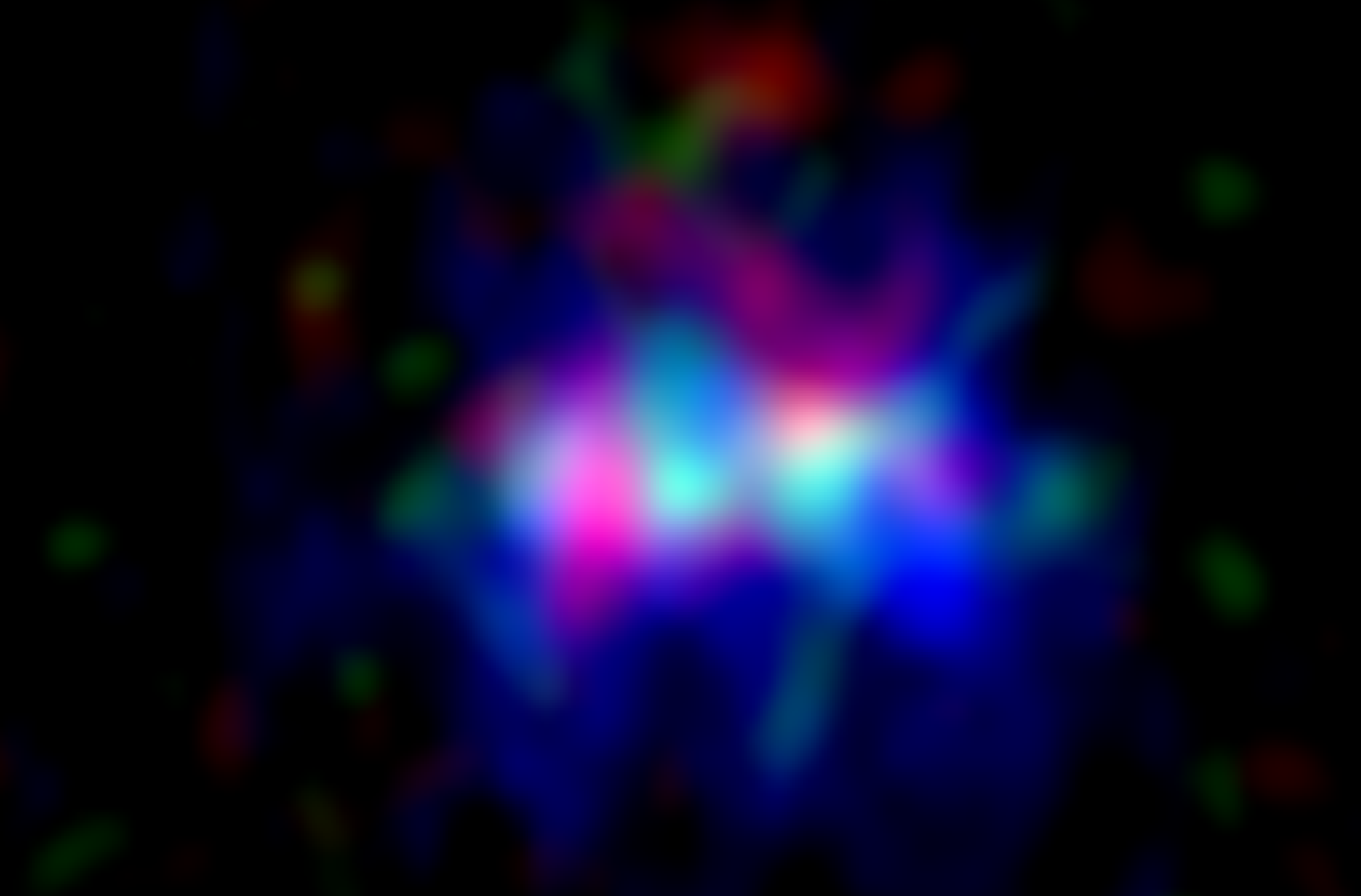ALMA and James Webb Observe the Most Distant Galaxy Protocluster
An international collaboration led by Assistant Professor Takuya Hashimoto (University of Tsukuba, Japan) and Researcher Javier Álvarez-Márquez (Spanish Center for Astrobiology) has used the James Webb Space Telescope (JWST) and the Atacama Large Millimeter/submillimeter Array (ALMA) to observe the most distant galaxy protocluster to date, 13.14 billion light-years away1. This profound observation has revealed this protocluster's dense 'metropolitan' core, indicating accelerated galaxy growth. Simulations suggest this region will merge into a singular, massive galaxy in the forthcoming tens of millions of years, offering insights into early galactic birth and evolution.
Studying how individual stars are born and die in galaxies, how new stars are born from remnants of old stars, and how galaxies grow are important themes in astronomy, as they provide insight into our roots in the Universe. Galaxy clusters, one of the most significant structures in the Universe, assemble more than 100 galaxies bound together through mutual gravitational force. Observations of nearby galaxies have shown that the growth of a galaxy depends on its environment in the sense that mature stellar populations are commonly seen in regions where galaxies are densely collected. This is referred to as the "environment effect."
Although the environment effect has been considered an essential piece to understanding galaxy formation and evolution, it is not well known when it was initiated in the history of the Universe. One of the keys to understanding this is to observe the ancestors of galaxy clusters shortly after the birth of the Universe, known as galaxy protoclusters (hereafter protoclusters); these are assemblies of about ten distant galaxies. Fortunately, astronomy allows us to observe the distant Universe as it was in the past. For example, light from a galaxy 13 billion light-years away takes 13 billion years to reach Earth, so what we observe now is what that galaxy looked like 13 billion years ago. However, light that travels 13 billion light-years becomes fainter, so the telescopes that observe it must have high sensitivity and spatial resolution.
The research team first observed the core region of this protocluster using JWST. Using NIRSpec, an instrument that observes spectra at wavelengths ranging from visible to near-infrared, the team made integral field spectroscopy observations that can simultaneously acquire spectra from all locations within the field of view. The team has successfully detected ionized oxygen-ion light ([OIII] 5008 Å) from four galaxies in a quadrangle region measuring 36,000 light-years along a side, which is equivalent to half the radius of the Milky Way galaxy. Based on the redshift of this light (the elongation of the wavelength due to the cosmic expansion), the distance of the four galaxies from the Earth was identified as 13.14 billion light years. "I was surprised when we identified four galaxies by detecting oxygen-ion emission at almost the same distance. The 'candidate galaxies' in the core region were indeed members of the most distant protocluster," says Yuma Sugahara (Waseda/NAOJ), who led the JWST data analysis.
In addition, the research team paid attention to the archival ALMA data, which had already been acquired for this region. The data captures radio emission from cosmic dust in these distant galaxies. As a result of analyses, they detected dust emissions from three of the four galaxies. This is the first detection of dust emission in member galaxies of a protocluster this far back in time. Cosmic dust in galaxies is thought to be supplied by supernova explosions at the end of the evolution of massive stars in the galaxies, which provide the material for new stars. Therefore, large amounts of dust in a galaxy indicate that many of the first-generation stars in the galaxy have already completed their lives and that the galaxy is growing. Professor Luis Colina (Centro de Astrobiología (CAB, CSIC-INTA)) describes the significance of the results: "Emission from cosmic dust was not detected in member galaxies of the protocluster outside the core region. The results indicate that many galaxies are clustered in a small region and that galaxy growth is accelerated, suggesting that environmental effects existed only ~700 million years after the Big Bang."
Furthermore, the research team conducted a galaxy formation simulation to theoretically test how the four galaxies in the core region formed and evolved. The results showed that a region of dense gas particles existed around 680 million years after the Big Bang, and that four galaxies are formed, similar to the observed core region. To follow the evolution of these four galaxies, the simulation calculated physical processes such as the kinematics of stars and gas, chemical reactions, star formation, and supernovae. The simulations showed that the four galaxies merge and evolve into a single larger galaxy within a few tens of millions of years, which is a short time scale in the evolution of the Universe. "We successfully reproduced the properties of the galaxies in the core region owing to the high spatial resolution of our simulations and the large number of galaxy samples we have. In the future, we would like to explore the formation mechanism of the core region and its dynamical properties in more detail," says Yurina Nakazato, a graduate student at the University of Tokyo, who analyzed the simulation data.
Javier Álvarez-Márquez (Spanish Center for Astrobiology) says, "We will conduct more sensitive observations of the protocluster A2744z7p9OD with ALMA to see if there are any galaxies that were not visible with the previous sensitivity. We will also apply the JWST and ALMA observations, which have proven to be very powerful, to more protoclusters to elucidate the growth mechanism of galaxies, and to explore our roots in the Universe."
Additional Information
These results have been accepted for publication in The Astrophysical Journal Letters as "Reionization and the ISM/Stellar Origins with JWST and ALMA (RIOJA): The core of the highest redshift galaxy overdensity confirmed by NIRSpec/JWST" on August 30, 2023, and will be published in the journal.
The research team members are Takuya Hashimoto (University of Tsukuba), Javier Álvarez-Márquez (Centro de Astrobiología (CAB), CSIC-INTA), Yoshinobu Fudamoto (Chiba University), Luis Colina (Centro de Astrobiología (CAB), CSIC-INTA), Akio K. Inoue (Waseda University), Yurina Nakazato (University of Tokyo), Daniel Ceverino (Universidad Autonoma de Madrid/CIAFF), Naoki Yoshida (University of Tokyo, Kavli IPMU), Luca Costantin (Centro de Astrobiología (CAB), CSIC-INTA), Yuma Sugahara (Waseda University/NAOJ), Alejandro Crespo Gómez (Centro de Astrobiología (CAB), CSIC-INTA), Carmen Blanco-Prieto (Centro de Astrobiología (CAB), CSIC-INTA), Ken Mawatari (University of Tsukuba), Santiago Arribas (Centro de Astrobiología (CAB), CSIC-INTA), Rui Marques-Chaves (University of Geneva), Miguel Pereira-Santaella (Instituto de Física Fundamental (IFF), CSIC), Tom J.L.C. Bakx (Chalmers University of Technology), Masato Hagimoto (Nagoya University), Takeshi Hashigaya (Kyoto University), Hiroshi Matsuo (NAOJ/SOKENDAI), Yoichi Tamura (Nagoya University), Mitsutaka Usui (University of Tsukuba), Yi W. Ren (Waseda University)
This text is based on the original Press Release by the National Astronomical Observatory of Japan (NAOJ), an ALMA partner on behalf of East Asia.
The Atacama Large Millimeter/submillimeter Array (ALMA), an international astronomy facility, is a partnership of the European Organisation for Astronomical Research in the Southern Hemisphere (ESO), the U.S. National Science Foundation (NSF) and the National Institutes of Natural Sciences (NINS) of Japan in cooperation with the Republic of Chile. ALMA is funded by ESO on behalf of its Member States, by NSF in cooperation with the National Research Council of Canada (NRC) and the National Science and Technology Council (NSTC) in Taiwan and by NINS in cooperation with the Academia Sinica (AS) in Taiwan and the Korea Astronomy and Space Science Institute (KASI).
ALMA construction and operations are led by ESO on behalf of its Member States; by the National Radio Astronomy Observatory (NRAO), managed by Associated Universities, Inc. (AUI), on behalf of North America; and by the National Astronomical Observatory of Japan (NAOJ) on behalf of East Asia. The Joint ALMA Observatory (JAO) provides the unified leadership and management of the construction, commissioning and operation of ALMA.
Images




Notes
- The redshift of this object was z = 7.88. Based on this, calculating the distance using the latest cosmological parameters (H0 = 67.7 km/s/Mpc, Ωm = 0.3111, ΩΛ = 0.6899) yields 13.14 billion light years. The distance for A2744z7p9OD was first determined by the team of Takahiro Morishita (California Institute of Technology). ↩︎
Contacts
-
Nicolás Lira
Education and Public Outreach OfficerJoint ALMA Observatory, Santiago - ChilePhone: +56 2 2467 6519Cel: +56 9 9445 7726Email: [email protected] -
Naoko Inoue
EPO officer, ALMA ProjectNational Astronomical Observatory of Japan (NAOJ)Email: [email protected] -
Bárbara Ferreira
ESO Media Manager -
Jill Malusky
Public Information Officer






